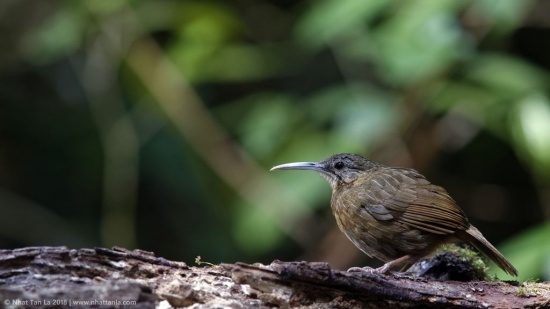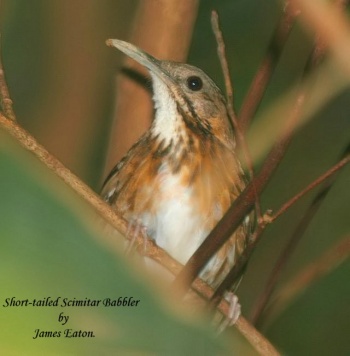(Including Naung Mung Scimitar Babbler) |
(Picture showing profile, basic tidy-up. Links References updated) |
||
| Line 1: | Line 1: | ||
| − | [[Image: | + | [[Image:NTL0043-s.jpg|thumb|550px|right|Photo by {{user|nhattanla|nhattanla}}<br>Da Lat, [[VietNam]], April 2018]] |
'''Alternative names: Indochinese Wren Babbler; Danjou's Babbler''' | '''Alternative names: Indochinese Wren Babbler; Danjou's Babbler''' | ||
;[[:Category:Jabouilleia|Jabouilleia]] danjoui | ;[[:Category:Jabouilleia|Jabouilleia]] danjoui | ||
'''Includes: Naung Mung Scimitar Babbler''' | '''Includes: Naung Mung Scimitar Babbler''' | ||
==Identification== | ==Identification== | ||
| − | With 18 - 19 cm a medium-sized babbler<sup>[[#References|1]]</sup>: | + | [[Image:Short-tailed_Scimitar_Babbler.jpg|thumb|350px|right|Photo by {{user|James+Eaton|James Eaton}}<br>Boch Ma, [[Vietnam]], March 2007 ]] |
| + | With 18 - 19 cm (7-7½ in); a medium-sized babbler<sup>[[#References|1]]</sup>: | ||
* Brown above, buff and white below | * Brown above, buff and white below | ||
* Long, black, decurved bill | * Long, black, decurved bill | ||
| − | * Greyish-brown ear-coverts | + | * Greyish-brown ear-[[Topography#General Anatomy|coverts]] |
| − | * Brown to black moustachial and malar lines | + | * Brown to black [[Topography#Heads|moustachial]] and [[Topography#Heads|malar]] lines |
* White throat | * White throat | ||
| − | + | ====Variations==== | |
| + | ''naungmungensis'' much darker than nominate | ||
==Distribution== | ==Distribution== | ||
Mainly in [[Vietnam]] and adjacent southern [[Laos]]. A small population in [[Myanmar]].<br /> | Mainly in [[Vietnam]] and adjacent southern [[Laos]]. A small population in [[Myanmar]].<br /> | ||
Restricted range species, generally uncommon but common locally, eg [[Bach Ma National Park]] or [[Ho Ke Go Nature Reserve]]. | Restricted range species, generally uncommon but common locally, eg [[Bach Ma National Park]] or [[Ho Ke Go Nature Reserve]]. | ||
==Taxonomy== | ==Taxonomy== | ||
| + | The species is sometimes also placed in the genus ''[[:Category:Rimator|Rimator]]'' and named Indochinese Wren Babbler<sup>[[#References|1]]</sup>.<br /> | ||
| + | Clements now places this species in the genus [[:Category:Napothera|Napothera]]. | ||
| + | ====Subspecies==== | ||
Three subspecies are recognized: | Three subspecies are recognized: | ||
* ''J. d. danjoui'' in S [[Vietnam]] | * ''J. d. danjoui'' in S [[Vietnam]] | ||
| Line 20: | Line 25: | ||
* ''J. d. naungmungensis'' in the Naung Mung area in Kachin State, [[Myanmar]] | * ''J. d. naungmungensis'' in the Naung Mung area in Kachin State, [[Myanmar]] | ||
''naungmungensis'' is sometimes accepted as full species.<br /> | ''naungmungensis'' is sometimes accepted as full species.<br /> | ||
| − | + | ||
| − | |||
==Habitat== | ==Habitat== | ||
Primary and secondary broadleaf evergreen forest. Also found in rocky areas, up to 2100m. | Primary and secondary broadleaf evergreen forest. Also found in rocky areas, up to 2100m. | ||
==Behaviour== | ==Behaviour== | ||
| − | Believed to feed on invertebrates, foraging on the ground or just above, in dense vegetation. Usually found single, in pairs or small family parties. | + | ====Diet==== |
| − | Breeds from January to April in Vietnam, lays 2 eggs. No other data. | + | Believed to feed on invertebrates, foraging on the ground or just above, in dense vegetation. Usually found single, in pairs or small family parties. |
| + | ====Breeding==== | ||
| + | Breeds from January to April in Vietnam, lays 2 eggs. No other data. | ||
| + | ====Movements==== | ||
Resident.<sup>[[#References|1]]</sup><br/> | Resident.<sup>[[#References|1]]</sup><br/> | ||
==References== | ==References== | ||
| − | #{{Ref- | + | #{{Ref-Clements6thAug17}}#{{Ref-HBWVol12}} |
{{ref}} | {{ref}} | ||
==External Links== | ==External Links== | ||
Revision as of 23:18, 15 April 2018
Alternative names: Indochinese Wren Babbler; Danjou's Babbler
- Jabouilleia danjoui
Includes: Naung Mung Scimitar Babbler
Identification
With 18 - 19 cm (7-7½ in); a medium-sized babbler1:
- Brown above, buff and white below
- Long, black, decurved bill
- Greyish-brown ear-coverts
- Brown to black moustachial and malar lines
- White throat
Variations
naungmungensis much darker than nominate
Distribution
Mainly in Vietnam and adjacent southern Laos. A small population in Myanmar.
Restricted range species, generally uncommon but common locally, eg Bach Ma National Park or Ho Ke Go Nature Reserve.
Taxonomy
The species is sometimes also placed in the genus Rimator and named Indochinese Wren Babbler1.
Clements now places this species in the genus Napothera.
Subspecies
Three subspecies are recognized:
- J. d. danjoui in S Vietnam
- J. d. parvirostris in Central Vietnam and adjacent S Laos
- J. d. naungmungensis in the Naung Mung area in Kachin State, Myanmar
naungmungensis is sometimes accepted as full species.
Habitat
Primary and secondary broadleaf evergreen forest. Also found in rocky areas, up to 2100m.
Behaviour
Diet
Believed to feed on invertebrates, foraging on the ground or just above, in dense vegetation. Usually found single, in pairs or small family parties.
Breeding
Breeds from January to April in Vietnam, lays 2 eggs. No other data.
Movements
Resident.1
References
- Clements, J. F., T. S. Schulenberg, M. J. Iliff, D. Roberson, T. A. Fredericks, B. L. Sullivan, and C. L. Wood. 2017. The eBird/Clements checklist of birds of the world: v2017, with updates to August 2017. Downloaded from http://www.birds.cornell.edu/clementschecklist/download/
- Del Hoyo, J, A Elliott, and D Christie, eds. 2007. Handbook of the Birds of the World. Volume 12: Picathartes to Tits and Chickadees. Barcelona: Lynx Edicions. ISBN 978-8496553422
Recommended Citation
- BirdForum Opus contributors. (2024) Short-tailed Scimitar Babbler. In: BirdForum, the forum for wild birds and birding. Retrieved 11 June 2024 from https://www.birdforum.net/opus/Short-tailed_Scimitar_Babbler





